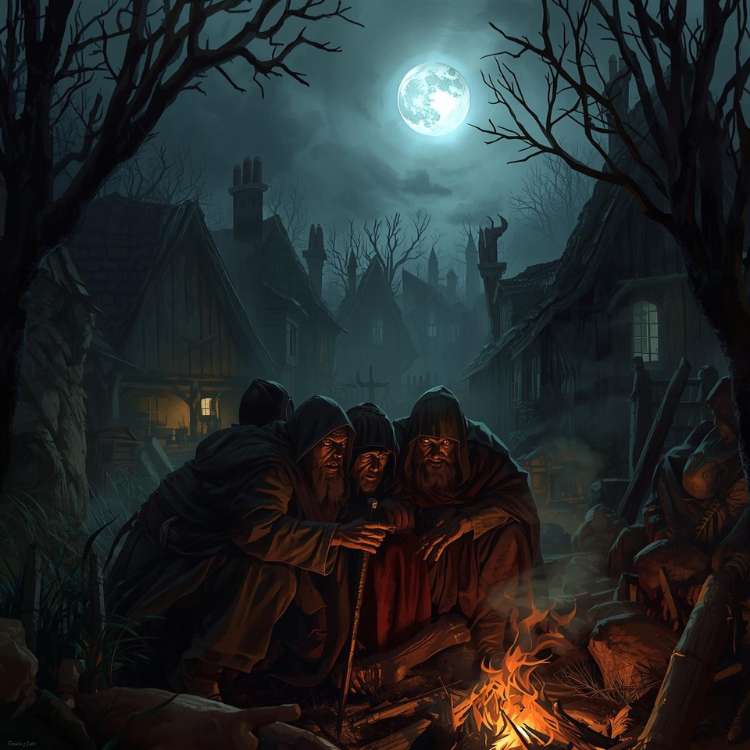
Understanding the Anxieties That Shaped Medieval Life
When we think of the Middle Ages, we often imagine knights, castles, and cathedrals. But behind the romance of chivalry and Gothic art, there was a world filled with deep fears — of disease, damnation, hunger, war, and the unknown. 🏰⚔️
Life in medieval Europe (roughly from the 5th to the 15th century) was hard and uncertain. People faced constant dangers from nature, war, and invisible spiritual forces. Fear wasn’t just a passing emotion — it was a core part of everyday life, shaping beliefs, behaviors, and institutions.
This article explores the main fears that haunted medieval people, how those fears were expressed, and how they influenced medieval society, religion, and culture.
🌍 A World of Danger and Uncertainty
To understand medieval fears, we must first imagine what life was like back then.
There were no hospitals as we know them, no police forces to keep order, and no scientific explanations for most natural phenomena. Diseases, storms, or famines seemed to come directly from God or the Devil.
Most people lived in small rural communities, far from cities, often isolated and vulnerable. Survival depended on the harvest, the weather, and divine protection.
In such a fragile world, fear was both rational and ever-present.
⚰️ The Fear of Death and the Afterlife
Perhaps the greatest medieval fear was death — not simply dying, but what came after.
In a deeply religious society, the Church taught that after death, every soul would face judgment. The righteous went to heaven, the sinners to hell, and many others to purgatory, a place of purification through suffering.
🔥 Hell was not an abstract concept — it was vividly described in sermons, art, and literature. People truly believed in eternal fire, demons, and endless torment.
Medieval churches were filled with terrifying images of devils dragging sinners into flames. These were not meant to entertain but to instill moral fear and encourage repentance.
Fun fact: Paintings of the Last Judgment — such as those in French cathedrals or by artists like Giotto — were among the most powerful “moral warnings” of the time.
🦠 The Fear of Disease: The Black Death
Few events in history inspired more collective terror than the Black Death (1347–1351).
This plague killed an estimated one-third of Europe’s population in just a few years. Whole towns were wiped out. Corpses filled the streets. No one knew the cause — some blamed bad air (miasma), others divine punishment or witchcraft.
👑 Even kings and priests were not safe. The Black Death showed the fragility of human life, shaking faith and social order.
People sought explanations and comfort through religion:
- Some turned to flagellation, whipping themselves to atone for sins.
- Others persecuted minority groups, like Jews, accusing them of poisoning wells.
- Still others withdrew completely from society, forming apocalyptic cults.
The fear of another plague never fully disappeared — and would return many times in later centuries.
⚔️ The Fear of War and Invasion
Medieval Europe was rarely at peace. Wars between kings, invasions by Vikings or Mongols, and endless feudal conflicts made violence a part of daily life.
For peasants, the approach of an army meant burned crops, destroyed homes, and famine. Even nobles feared betrayal, siege, or death in battle.
🔔 Castles and city walls were not just symbols of power — they were defenses built out of fear.
Some of the most traumatic invasions included:
- The Viking raids (8th–10th centuries), which terrorized coastal villages.
- The Mongol invasions in Eastern Europe (13th century), described as the “scourge of God.”
- The Hundred Years’ War (1337–1453), which devastated France and England.
Medieval chronicles often described war not as heroism, but as chaos and suffering — proof that fear, not glory, ruled the battlefield.
🌩️ Fear of Nature and the Supernatural
Before modern science, nature itself inspired deep fear.
Thunderstorms, floods, eclipses, or famines were seen as signs of divine anger. If crops failed, it was believed that someone had sinned or that witchcraft was at work.
🌑 Eclipses were seen as omens. A darkened sun might mean the death of a king or the end of the world.
To protect themselves, people relied on religious rituals, relics, and prayers. Churches rang bells to drive away storms, and holy water was sprinkled to bless fields.
👻 The Fear of the Supernatural
Medieval people also believed the world was full of invisible beings — saints, angels, demons, and ghosts.
Stories of the walking dead, demonic possession, and witches circulated widely. Many believed that the Devil was constantly trying to tempt humans into sin.
Even educated people took these fears seriously. Theologians debated how demons could influence the material world, while inquisitors searched for witches and heretics.
⛪ The Fear of Sin and Divine Punishment
The Catholic Church played a central role in shaping and controlling fear.
Priests constantly reminded the faithful that every action could bring divine judgment. A single unconfessed sin could mean eternal damnation.
Confession, penance, and indulgences were ways to ease spiritual anxiety. Yet, the Church also used fear as a powerful tool to maintain authority.
🔥 Fear of excommunication — being cut off from the Church — was one of the strongest social weapons of the time. It could ruin reputations, destroy families, and even dethrone kings.
Apocalyptic fears were also common. Many people believed the End of the World was near, interpreting famines, wars, and plagues as signs of the Last Judgment.
🧙♀️ Fear of Witches, Heretics, and the Devil
Though the great witch hunts came later, in the 15th–17th centuries, the roots of witchcraft fear lay deep in the medieval mind.
The idea that humans could make pacts with the Devil or use magic to harm others spread widely through sermons and legends.
👁️🗨️ Heretics — those who questioned Church doctrine — were also feared and persecuted. The Inquisition, founded in the 13th century, aimed to detect and punish those seen as a threat to religious unity.
This wasn’t only about theology — it reflected a deeper fear of social disorder. In a world where religion shaped every aspect of life, questioning faith meant questioning reality itself.
🌾 Fear of Famine and Poverty
Most medieval Europeans lived very close to starvation.
Bad weather, poor harvests, or wars could easily lead to famine. In some years, thousands died simply because crops failed.
Bread — the main food for most people — became a symbol of survival. When there was no bread, panic and despair spread quickly.
The Great Famine (1315–1317) was one of the worst in history. Heavy rains destroyed crops, livestock died, and desperate people resorted to eating roots or bark.
This constant fear of hunger shaped social life, family size, and even religion, as people prayed for divine mercy and good harvests. 🌾🙏
🧔 Fear of the “Other”
Medieval Europe was also filled with fears of strangers and minorities.
People distrusted anyone who looked, spoke, or believed differently — Jews, Muslims, foreigners, and even lepers.
During the Black Death, Jews were falsely accused of spreading the plague, leading to massacres across Europe. Lepers were isolated and stigmatized, as many believed their disease was a punishment from God.
These fears reflected a society that valued unity and control, where difference was often seen as a threat to divine order.
📚 Fear in Medieval Art and Literature
Fear wasn’t only lived — it was represented. Medieval art and literature are full of visions of hell, monsters, and moral warnings.
From Dante’s Inferno to illuminated manuscripts depicting demons and torments, fear served a didactic purpose: to teach moral lessons and remind believers of divine justice.
🎭 Medieval theatre also reflected this — mystery plays and morality plays dramatized sin, punishment, and redemption to move audiences to repentance.
🌅 Overcoming Fear: Faith, Ritual, and Community
Despite their fears, medieval people weren’t helpless victims. They developed spiritual and social strategies to cope with anxiety.
- Faith gave meaning to suffering.
- Pilgrimages and relics offered hope and healing.
- Festivals, music, and communal prayers created joy and belonging.
Fear, in many ways, brought people together — reminding them of their shared fragility and dependence on divine grace. ✨
🕊️ Conclusion: A Civilization Shaped by Fear
The Middle Ages were not an “age of darkness,” but an age where fear was a constant teacher.
From disease and hunger to sin and the supernatural, medieval fears reflected a world deeply aware of its vulnerability. Yet these fears also inspired art, faith, and community — driving the creation of cathedrals, the rise of universities, and the moral imagination of Europe.
💡 Understanding the fears of medieval people helps us see not only their world, but also our own. Even today, humanity still struggles with invisible threats — pandemics, wars, and moral uncertainty. The difference is that medieval fear was collective and spiritual, while ours is often individual and psychological.
The lesson remains timeless: fear is both a burden and a force that shapes civilization.
📚 Sources
- Le Goff, Jacques. Medieval Civilization 400–1500. Wiley-Blackwell, 2012.
- Delumeau, Jean. Sin and Fear: The Emergence of a Western Guilt Culture, 13th–18th Centuries.
- Cantor, Norman F. The Civilization of the Middle Ages. Harper Perennial, 1994.
- Tuchman, Barbara. A Distant Mirror: The Calamitous 14th Century. Ballantine Books, 1978.
- Huizinga, Johan. The Waning of the Middle Ages. Dover Publications, 1999.

